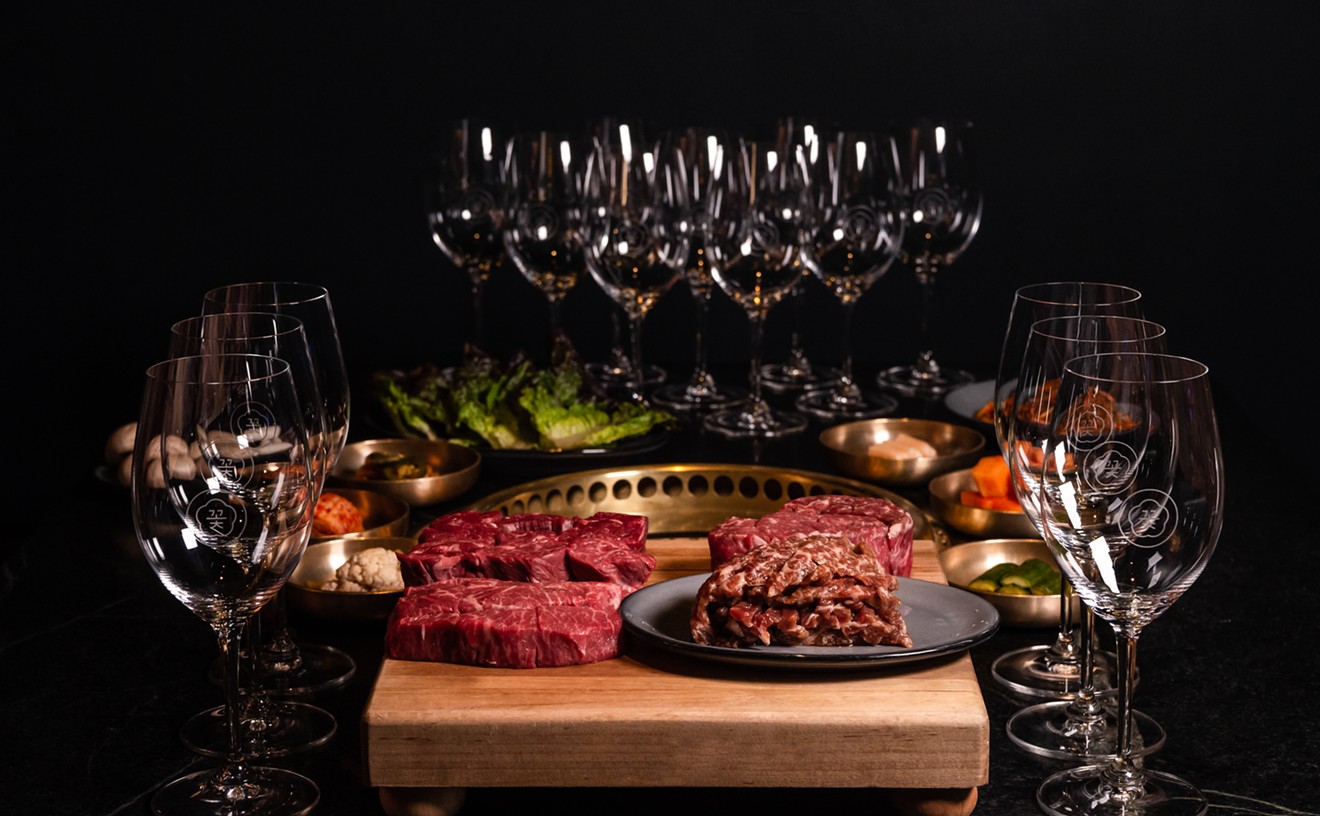The chapulines are boiled, sun-dried, and roasted in garlic and chilies before they're vacuum-packed and sent north from Oaxaca. Then these grasshopper slivers are tossed in a pan with citrusy Sichuan peppercorns and topped with cilantro and lime. Broken into pieces and served with peanuts and almonds, the bug bits are mostly innocuous and unidentifiable. They add some crunch and tartness to the little snack and double as a kind of Boy Scout badge for food enthusiasts.
To serve grasshoppers is a risky move. But that's expected of Alex Chang, the 25-year-old chef who helms the Vagabond Restaurant & Bar. The 120-seater opened earlier this month as part of a multimillion-dollar hotel renovation that aimed to restore the complex to its mid-20th-century glory.
The restaurant's interior was revived with sleek retro furniture. Curvaceous, black-and-white Saarinen chairs surround solid wood tables that rest on narrow, circular pedestals. Two-foot-wide ceiling lamps that look like metal spheres burst with light that bathes the room in a cool glow and highlights celestial orbit patterns meticulously etched into the ceiling.
A sunken bar at the center offers a brief, affordable wine list that favors France alongside a concise cocktail selection. The Upper Eastsider -- a blend of gin with the elderflower liqueur St-Germain, vermouth, cucumber, and absinthe -- is a light, bright apéritif.
Still, Chang, a Mexican-Chinese cook with a thin mustache and short-cropped hair topped by a jet-black bun, is the main attraction. The Vagabond's marketing machine promoted him relentlessly ahead of the winter opening, and it was enough to earn him a "30 Under 30" nod from Google-owned Zagat before the place served its first paying customer. He was catapulted into this quasi-culinary stardom following the 2013 premiere of the documentary Paladar, which described an illegal restaurant he and roommates ran out of their apartment while students at the University of Southern California.
After graduation, Chang embarked on a worldwide trip, with stays in vaunted kitchens stretching from Tokyo to Belgium, as well as a two-year stint at Los Angeles' James Beard Award-winning Animal Restaurant.
Yet Chang's very respectable resumé isn't quite as alluring as the world glimpsed in the documentary. The sepia-tinted hour of shaky footage is soaked in booze, testosterone (mostly courtesy of former roommate Robert Kronfli), and an enthusiasm for hospitality. What began as a way to offer friends a homestyle alternative to overpriced fast food quickly takes off. Weekly dinners grow from 12 to more than 60 diners, and the three-course, $15 menu evolves from roast chicken and cheeseburgers to oysters and squid-ink pasta. Hundreds of hopefuls remain on an email waiting list while Chang and his merry band chug cans of Pabst Blue Ribbon while cooking in a cramped kitchen ventilated by a box fan.
You won't get this kind of excitement at the Vagabond. Just as the Ramones and Blondie grew out of the legendary Lower Manhattan punk club CBGB, Chang sprang from Paladar. Today he is stoic and runs a well-oiled kitchen. He suspiciously eyes dishes as they leave the kitchen and consults with servers to gather diners' feedback. Yet it's clear from the deceivingly simple one-page menu that the naiveté and enthusiasm that propelled a college kid to open an ad hoc restaurant is alive and well.
In addition to cooking with grasshoppers, Chang also experiments with offal and odd cuts. He plates them with familiar ingredients to quell and delight the squeamish. Ruby-red beef hearts are the starting point for a pivot off sukiyaki, a Japanese-style hot pot traditionally garnished with chrysanthemums, mushrooms, and green onions. His artful approach abandons the broth and instead marinates the meat in sake, soy sauce, and mirin before a fast, hard sear. Despite the cut's lean texture, thin slices against the grain result in butter-soft bites that gather richness from the accompanying warmed egg yolk.
Equally delicate are sweetbreads fried golden outside but still silky within. Chang says they're a tribute to Miami but, like the beef hearts, call for some explanation. "It's inspired by a medianoche sandwich and a milanesa," he says. The creamy glands are paired with an almost overly rich Swiss-cheese foam bound with cream and potato that has a cloud-like texture. But a country ham vinaigrette and an inky slick of burnt onion mustard -- made of charred onions blended with mayonnaise, brown sugar, and apple cider vinegar -- provide a hit of acid at just the right moment.
The perfect crust on a buttermilk-soaked fried quail also hides a few morsels of the bird's delicate meat, but this time the plate looks South (or north, rather). Plump, fragrant grains of Carolina Gold rice, cooked pilaf-style with onions and butter, cling to a salty, savory gravy made of rendered Benton's bacon and cream with bitter collard greens that help lighten each bite.
There are also nearly a dozen vegetable preparations that are as thoughtful and nuanced as their protein counterparts. The highlight is a roasted carrot dish sprinkled with crushed hazelnuts and the grassy, nutty Middle Eastern spice blend zaatar with an unusual take on Mexico's iconic mole. Carrots and onions are cooked with hazelnuts, dried chilies, and Mexican oregano before being simmered in carrot juice, blended, and strained. Though the thick sauce can't be fairly compared to the real deal -- a blend of chocolate, nuts, and chilies ground and cooked for dozens of hours -- it adds a deep, caramelized undertone that embellishes the almost al dente baby carrots that compose the bulk of the plate.
Similarly intense slicks wait under cubes and ribbons of deep-orange kabocha squash. Tangy whipped chicken livers intensify the sweet, simply roasted gourd glazed in umami-laced white miso.
Then there are the thick triangles of firm, meaty wahoo seared and placed atop mounds of corn pudding that's made by thickening macerated kernels in their own juices with a bit of vadouvan -- a pungent French take on the Indian spice blend masala that adds shallots and garlic. The combination is simple and smart, leaving nothing to be desired.
Such is the dichotomy of Chang's long-awaited Miami debut. On the one hand, he's determined not to compromise his cuisine. "I wasn't going to cook someone else's food," he says. "So when I wrote the menu, I kind of made it as crazy and adventurous as I wanted it to be." On the other, he knows when to show restraint, is soft-spoken, and shamelessly admits his apprehensions in taking on his first bona fide chef role. Sure, you can pine for his wide-eyed younger years, but Chang today is better trained and far more versatile. Let's hope he'll stick around for a while before becoming a vagabond again and wandering off to some far-flung, Michelin-starred kitchen.
- Peanuts and chapulines $6
- Pan-seared beef heart $13
- Roasted baby carrots $14
- Roasted kabocha squash $15
- Sweetbread milanesa $23
- Buttermilk fried quail $24
For more follow Zach on Twitter or Instagram.
Follow us on Facebook at Miami New Times Food & Drink.











